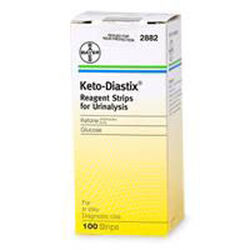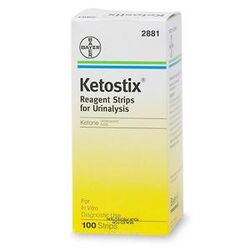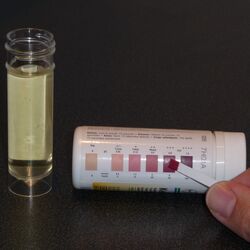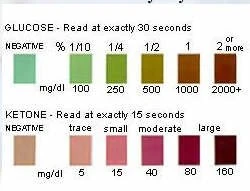
Ketodiastix. This type of urine test strip measures both glucose and ketones.

Ketostix. This type of test strip measures urine ketones only.
Human and animal diabetics both use ketostix or ketodiastix. These are reagent indicator strips that test urine for only ketone (ketostix) or for both ketones and glucose (ketodiastix).
These stix are available at any brick-and-mortar or Internet pharmacy that sells human diabetic supplies. Stix do expire, so check the unopened expiration date when you buy them and record the date you open them. Keep the bottle tightly closed when not in use; prolonged exposure to air can produce false negative urine ketone test result.s [1] Wal-Mart and Sam's Club sell a ReliOn branded urine ketone test strip made by Bayer, the maker of Ketostix. [2][3]
If the foil-wrapped Ketostix, rather than the ones in vials are purchased, you may find it less wasteful. After the bottle is opened, the remaining unused strips have only a 6 months' life. By using the foil-wrapped ones, you can extend the "life" of your purchase. The singly-wrapped ones can have a unopened expiration date of up to two years. You are then only using what you need when you need it, having the rest still sealed and potent until the indicated expiration date. [4]
Testing reasons[]
You should test your pet's urine for ketones for the reasons discussed at ketones. You may test your pet's urine for glucose because you've been instructed to do so by the vet as a method of gauging regulation or your pet is undiagnosed and you want to determine whether there is hyperglycemia.
Urine Glucose Testing[]
Some reasons for preferring testing glucose levels by using blood over urine testing is that the urine used in testing may have been in the bladder for hours. Because of this, it may not be a reliable indicator of what systemic glucose levels are at the time of testing. [5] What's seen when testing urine for glucose is an average of what the level of glucose has been over a period of about 5-8 hours (the time period from last urination).[6]
Urine testing [6] also makes it more difficult to determine whether any hyperglycemia noted is the result of a Somogyi rebound pattern or a true need for an increase in insulin dosage. [7] Urine only tests positive for glucose when the renal threshold has been exceeded for a length of time. [8]
There also must be some degree of glycosuria (glucose in urine) present in order for a urine test to detect development of hypoglycemia.[6]
With urine testing for glucose, getting a negative result means your pet is somewhere under the renal threshold of 180 mg/dl or 10 mmol. Glucose doesn't spill into the urine until at or above that point. This could mean he/she is in the euglycemic zone where all's well or that the dog is headed for the hypoglycemic one. Knowing that the pet's blood glucose levels are too low means that you can take action with a sugar source or some food to ward off a possible hypo episode.
Reading Results[]

Serious ketones detected in urine with Ketostix. The color of the test pad matches 80, or Large, on the Ketostix color chart. Medical intervention is needed right away.
Evaluating the results. The stix [9] bottle has instructions and color charts to show you how the color on the stix will change given the level of ketones/glucose in the urine over 15 (ketones-Ketostix) or 30 (glucose-Ketodiastix) seconds. Be sure to read the colors at those time intervals because the colors will continue to darken and a later reading will be an incorrect result. Timing with a clock or watch second hand instead of counting is said to be more accurate. [4]
It's important to time the test accurately and not take into account any color changes on the Ketostix strip which occur after 15 seconds. [10]
- If you see a "trace" or more of ketones, see ketones.
|
In a diabetic, any urinary ketones above trace, or any increase in urinary ketone level, or trace urinary ketones plus some of the symptoms above, are cause to call an emergency vet immediately, at any hour of the day. | ||
When testing urine for ketones, the sample needs to be as fresh as possible. Ketones evaporate quickly, so there's a chance of getting a false negative test result if you're testing older urine. [11]
At low levels, ketones can be detected in the urine (ketonuria) before they are found in the blood (ketonemia/ketonaemia). [12]

Ketodiastix--measures urine glucose and ketones.
- The glucose portion of the stix measures your pet's glycosuria--that is, the glucose that has collected in your pet's bladder since s/he last urinated. If you see any color change in the glucose portion of the stix, that means that your pet has exceeded its renal threshold since it last urinated. The darker the color, the higher your pet's BG level has been since its last urination. Note that positive urinary glucose results are not indicative of your pet's blood glucose level at the time it urinated. No meaningful conversion between urine glucose and blood glucose readings is possible.

Ketostix--measures urine ketones.
- If you are testing urine for glucose, the time you test likely affects results in this way: mid-day urine glucose tests would reflect the nadir of glucose in the system--this also represents the peak of the insulin. Morning urine glucose tests are frequently high. Seeing negative urine glucose test, especially repeated negative ones, can mean the pet is approaching hypoglycemia. [13]
Good BG Readings but Positive Ketone Results[]
When the bg readings are high enough to produce some ketones, you've taken action to bring them down and they are normal once more, it is possible to still see some positive urine ketone test results. Ketones show up in the urine right away. When you're getting normal bg readings, it means that there are no more ketones being produced. What you are seeing when you test urine for ketones and the blood glucose is in normal ranges are the "leftovers" of the ketones which were produced by the high bg episode. They will continue to show up in the urine for a while but their concentration will become less and less until they're gone. [14][15]
False Testing Results-Urine Glucose[]
|
Possible False Urine Glucose Test Results--Antibiotics | |
|---|---|
| Antibiotic [16]/Sulfa [17][18][19] drug name | Effects |
| cephalexin, Keflex, [20] Cephorum (UK), [21] Rilexine [22] Cefixime/Suprax [23] Cefotixin/Mefoxin [24] Cefpodoxime Proxetil/Simplicef [25]Cefotaxime/Claforan [26] other cephalosporin antibiotics [27] enrofloxacin, [28] Baytril [29] |
less than accurate (false negatives & positives) urine glucose test results [30] |
| Gantrisin, Septra, Bactrim, Albon [31],Duphatrim [32] Tribrissen (UK) [33], Trinacol (UK) [34] more names at link [35] |
can alter urine glucose test results [36][37] |
| Chloramphenichol [38] Chloromycetin [39] |
can produce false urine glucose test results [40]. |
| Tetracycline, [41] Helidac, Sumycin, [42] Doxycycline [43] Doryx, Doxy 100 Monodox, Vibramycin Vibra-Tabs, Ronaxan (UK) [44] |
false urine glucose test results [45] |
| Penicillin and its derivatives ampicillin, carbenicillin ticarcillin, penicillin G other names at links [46][47] |
can produce false positive urine glucose test results [48]. |
|
Possible False Urine Glucose Test Results--Other Drugs | |
|---|---|
| Acetaminophen [49] (brand names) Tylenol |
Common use: Pain reliever. |
| Aspirin [50] | Common use: Pain reliever. False positives possible (urine test brand name Clinitest.) False negatives possible (urine test brand names Clinistix or TesTape.) |
| Salicylates Pepto-Bismol, etc. [51] |
Common use: Diarrhea. False positives possible (urine test brand name Clinitest.) False negatives possible (urine test brand names Clinistix or TesTape.) |
| Phenazopyridine Pyridium, Geridium, Pyridiate, or Urogesic |
Common use: Urinary tract infections. False positives possible (urine test brand name TesTape.) Delayed reactions possible (urine test brand names Clinistix or TesTape.) [52] |
| Diazepam [53] (brand names) Valium |
Negative. Common uses: Seizures, anxiety, muscle relaxant, appetite stimulant. (urine tests brand names Diastix and Clinistix.) |
| Blood Chemistry | Decreased blood glucose and cholesterol test levels. |
|---|---|
| Urine Testing | False high urine glucose test results (With urine test brand name Clinitest) [55]. |
| Urine Testing | False negative urine glucose test results (With urine test brand name Clinistix) [55]. |
| Urine Testing | False negative urine glucose test results With other urine test brand name strips. [11] |
|
Possible False Urine Glucose Test Results-Other Reasons | |
|---|---|
| Moderate Ketones [11] | Negative if glucose is only slightly elevated. |
| Increased Urine Specific Gravity [11] | Negative. |
| Decreased Temperature [11] | Negative-refrigerated samples. |
| Very Concentrated Urine | Negative [56]. |
| Expired Test Strips [11] | Negative. |
| Old Urine Sample [57] | Negative. Bacterial metabolism of urine at room temperatures for extended periods.[58]
|
| Contaminated Sample [11] | Positive with oxidant contamination such as bleach, hydrogen peroxide or formaldehyde. [59] |
| Cystitis [60] | Positive due to bacterial peroxidases. |
If your pet is taking any type of vitamin supplements, it should be noted on his or her medical records. Knowing that he/she is using them means being able to factor them into interpretations of test results.
False Testing Results-Urine Ketones[]
|
Because most urine tests measure acetoacetic acid, and not the most commonly found beta-hydroxybutyrate acid, it is possible to have ketones present and get a negative urine test result. Further, it's also possible to have high levels of beta-hydroxybutyrate acid, get a negative urine ketone test result, but to have the test turn positive as the ketosis improves, due to the tests' measuring acetoacetic acid and not beta-hydroxybutyrate acid. [61] | ||
|
Possible False Urine Ketone Test Results--Drugs and Supplements | |
|---|---|
| Valproic Acid (brand names) Depakene, Depakote, Divalproex Sodium [62] |
Positive. Common use: Treatment of epilepsy. |
| Cefixime/Suprax [63] | Positive with nitroprusside-based urine testing. Common use: Antibiotic. |
| Levadopa Metabolites [64] | Positive with high concentrations [11][65]. |
| Tricyclic Ring Compounds [66][67] | Positive. Common use: Treatment of depression. |
| Captopril- other drugs with free sulfhydryl groups [66] |
Positive. Captopril Common use: Hypertension (high blood pressure), various heart conditions, preserving kidney function in diabetic nephropathy [68][65]. |
| Phenazopyridine Pyridium, Geridium, Pyridiate, or Urogesic [69][70]. |
Positive. Common use: Urinary tract infections. |
| Glucocorticoids/Steroids [71] | Positive. Common use: Allergies, replacement therapy, others. |
| Vitamin C Supplements [72][65][10]. | Negative. |
|
Possible False Urine Ketone Test Results-Other Reasons | |
|---|---|
| Pigmented Urine [11] | Positive- Any other color except yellow or clear [73] May be the result of other disease processes. |
| Dehydration [69][74] | Positive or negative lack of fluids can concentrate ketones |
| samples with high specific gravity and low pH [75] |
Positive. |
| Old Urine Sample [11] | Negative- ketones can evaporate rapidly. [76]
|
| Older opened test strip container [77][10] | Negative |
If your pet is taking any type of vitamin supplements, it should be noted on his or her medical records. Knowing that he/she is using them means being able to factor them into interpretations of test results.
Getting samples[]
How to catch urine. Some people place the stix under their pet's stream when s/he is urinating. Others catch urine in a dedicated spoon, ladle, or other collection device and dip the stix into the urine. Intervet has internet pages with some ideas for performing urine tests on dogs. [78] More tips [79] on collecting uring samples for dogs. ![]()
References[]
- ↑ Precision Xtra-Blood Ketone Test Strips. Abbott Diabetes Care.
- ↑ ReliOn Ketone Urine Test Strips.
- ↑ ReliOn Ketone Urine Test Strip Instructions.
- ↑ 4.0 4.1 Chase, Peter. Understanding Diabetes-Ketone Testing. Barbara Davis Center for Diabetes. Cite error: Invalid
<ref>tag; name "Chase" defined multiple times with different content - ↑ Blood Glucose Curves. Pet Education.com-Drs. Foster & Smith.
- ↑ 6.0 6.1 6.2 Levitan, Diane Monsein (2001). Blood glucose monitoring-Glucose Testing-Blood vs Urine Tests. DVMNews.
- ↑ Cook, Audrey (2007). Latest Management Recommendations for Cats and Dogs with Nonketotic Diabetes Mellitus. DVM 360.
- ↑ Caninsulin-Monitoring-Page 5. Intervet.
- ↑ Ketone Strips. Diabetes Self-Management.
- ↑ 10.0 10.1 10.2 Hanas, Ragnar. Measuring Ketones in Urine. Children With Diabetes.
- ↑ 11.0 11.1 11.2 11.3 11.4 11.5 11.6 11.7 11.8 11.9 Sine, Cheryl S., et. al.. Urinalysis Dipstick Interpretations-Ketones. University of Georgia. Cite error: Invalid
<ref>tag; name "Sine" defined multiple times with different content Cite error: Invalid<ref>tag; name "Sine" defined multiple times with different content Cite error: Invalid<ref>tag; name "Sine" defined multiple times with different content Cite error: Invalid<ref>tag; name "Sine" defined multiple times with different content Cite error: Invalid<ref>tag; name "Sine" defined multiple times with different content Cite error: Invalid<ref>tag; name "Sine" defined multiple times with different content Cite error: Invalid<ref>tag; name "Sine" defined multiple times with different content Cite error: Invalid<ref>tag; name "Sine" defined multiple times with different content Cite error: Invalid<ref>tag; name "Sine" defined multiple times with different content - ↑ Urine Dipstick Tests-Glycosuria and Ketonuria. BMJ Student Archive.
- ↑ Better Medicine E-newsletter. Intervet (June 2006).
- ↑ Hanas, Ragnar (1999). Insulin Dependent Diabetes in Children, Adolescents and Adults-page 11-Important-Ketones. Children With Diabetes.
- ↑ Hanas, Ragnar. Urine Ketones Decrease Slowly. Children With Diabetes.
- ↑ Rees, Christine A., Boothe, Dawn M. (2004). Cephalexin/Keflex, Enrofloxacin/Baytril & Inaccurate Urine Glucose Testing in Dogs. Journal-American Veterinary Medical Association.
- ↑ Rickards, Rick. Sulfonamides. PetTalk.com.
- ↑ Rickards, Rick. Trimethoprim. PetTalk.com.
- ↑ Rickards, Rick. Ormetoprim. PetTalk.com.
- ↑ Cephalexin/Keflex Information. Medline Plus.
- ↑ Cephorum. NOAH Compendium-UK.
- ↑ Rilexine. NOAH Compendium-UK.
- ↑ Suprax/Cefixime. RxList.com.
- ↑ Cefotixin/Mefoxin. Petplace.com.
- ↑ Cefpodoxime Proxetil/Simplicef. Petplace.com.
- ↑ Cefotaxime/Claforan. Petplace.com.
- ↑ Dose Rates of Cephalosporins. Merck Veterinary Manual.
- ↑ Rickards, Rick. Enrofloxacin. PetTalk.com.
- ↑ Enrofloxacin/Baytril Information. PetPlace.com.
- ↑ Cephalosporins and Cephamycins-Special Clinical Concerns. Merck Veterinary Manual.
- ↑ Albon. Medi-Vet.com.
- ↑ Duphatrim. NOAH Compendium-UK.
- ↑ Tribrissen. NOAH Compendium-UK.
- ↑ Trinacol. NOAH Compendium-UK.
- ↑ Dose Rates of Sulfonamides. Merck Veterinary Manual.
- ↑ Sulfa Drugs by Brand Name & Hypoglycemia. Wellness.com.
- ↑ Sulfonamides and Sulfonamide Combinations-Special Clinical Concerns. Merck Veterinary Manual.
- ↑ Rickards, Rick. Chloramphenichol. PetTalk.com.
- ↑ Chloramphenichol/Chloromycetin & Blood Glucose. Healthtouch.
- ↑ Chloramphenicol and Congeners-Special Clinical Concerns. Merck Veterinary Manual.
- ↑ Rickards, Rick. Tetracycline. PetTalk.com.
- ↑ Tetracycline Medications & False Urine Test Results. Medline Plus.
- ↑ Rickards, Rick. Doxycycline. PetTalk.com.
- ↑ Ronaxan. NOAH Compendium-UK.
- ↑ Doxycycline Medications & False Urine Test Results. Medline Plus.
- ↑ Dose Rate of Penicillins-More Generic & Brand Names of Penicillin Family Drugs. Merck Veterinary Manual.
- ↑ Penicillins. Medline Plus.
- ↑ Penicillins-Special Clinical Concerns. Merck Veterinary Manual.
- ↑ Acetaminophen. Health.com.,
- ↑ Aspirin. Elephantcare.org.
- ↑ Bismuth subsalicylate. Elephantcare.org.
- ↑ Phenazopyridine. Merck Manuals Online.
- ↑ Diazepam/Valium. Elephantcare.org.,
- ↑ Rickards, Rick. Vitamin C. PetTalk.com.
- ↑ 55.0 55.1 55.2 Vitamin C & False Test Results in Pets. Provet UK.
- ↑ Taylor, Judith A. (November 2006). Urinalysis: Glucose. District of Columbia Academy-Veterinary Medicine.
- ↑ Optimizing Results with Urinalysis Dipsticks. Entrepreneur.com.
- ↑ Consequences of inappropriate urine specimen storage. Chronolab.
- ↑ Urine Glucose. Cornell University.
- ↑ Urine Glucose. Cornell University.
- ↑ Patient.co.uk-Ketones-False Positives, False Negatives. Patient.co.uk.
- ↑ Valproic Acid. NetDoctor UK.
- ↑ Suprax/Cefixime. RXList.com.
- ↑ Levadopa. Drugs.com.
- ↑ 65.0 65.1 65.2 Hanas, Ragnar. Measuring Ketones in Blood. Children With Diabetes.
- ↑ 66.0 66.1 Taylor, Judith A. (November 2006). Clinical Lab Medicine Harvesting The Gold: Interpretation and Techniques of Urinalysis. District of Columbia Academy of Veterinary Medicine.
- ↑ Tricyclic Antidepressant. Wikipedia.
- ↑ Captopril. Wikipedia.
- ↑ 69.0 69.1 Ketone Test Explained. Diabetes Explained. Cite error: Invalid
<ref>tag; name "Explained" defined multiple times with different content - ↑ Phenazopyridine. Merck Manuals Online.
- ↑ Ketones. Medline Plus.
- ↑ Precision Xtra Blood Ketone Test Strips. Abbott Diabetes Care.
- ↑ Taylor, Judith A. (November 2006). Urinalysis: What Is Abnormal?. District of Columbia Academy-Veterinary Medicine.
- ↑ Dehydration and Ketosis. North American Veterinary Conference (2003).
- ↑ Preanalytical Variables in Urine Testing. BD Diabetes (2006).
- ↑ Consequences of inappropriate urine specimen storage. Chronolab.
- ↑ Precision Xtra-When is it Recommended to Test?. Abbott Diabetes Care.
- ↑ Urine Test Hints for Dogs. Intervet.
- ↑ Collecting Urine Samples. Healthypet.com.
More Information[]
- Urinanalysis: Obtaining a Urine Sample Drs. Foster & Smith Pet Education Library
- Urinalysis Dipstick Interpretation Sine, Cheryl, et. al. 2003, University of Georgia
How to read multi-screen urine testing strips. - Introduction to Urinary System Merck Veterinary Manual
- Laboratory tests
- How Urine Dipsticks Work and Possible Quality Control Problems
- Urinalysis Using Test Strips Chronolab
- Urine Glucose Test Information-Multistix Cornell University
- Urine Ketone Test Information-Multistix Cornell University
- Urine Sample Collection Tips ProVet UK
- How home blood and urine tests measure blood glucose Wikipedia
- Diabetes Control-Insulin Richards, Mike, Vet Info 4 Dogs
- Weight Loss Secrets
- Dog ear infection
- Pancreatitis in dogs
- Ivermectin for dogs
Online Videos[]
- Cornell University-Feline Health Center-Urine Monitoring Flash Movie
How to Read Ketone Test Strips.